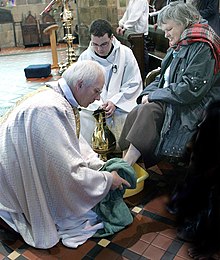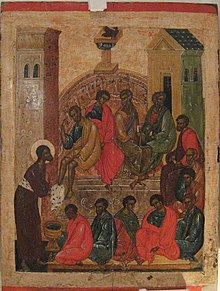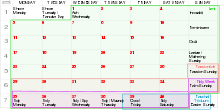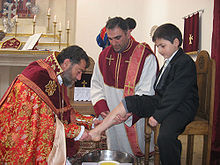ಸದಸ್ಯ:Abhisheksuvarna17/ಪವಿತ್ರ ಗುರುವಾರ
ಮಾಂಡೀ ಗುರುವಾರ ಕ್ರೈಸ್ತರ ಧಾರ್ಮಿಕ ಉತ್ಸವದ ಮುಖ್ಯ ದಿನಗಳಲ್ಲಿ ಒಂದು. ಈ ದಿನದಲ್ಲಿ ಕ್ರೈಸ್ತರು ಯೇಸು ಕ್ರಿಸ್ತನು ಅಂದಿನ ಅನೇಕ ಕೃತ್ಯಗಳನ್ನು ನಡೆಸಿದ ದಿನವನ್ನು ಸ್ಮರಿಸುತ್ತಾರೆ. ಈ ದಿನದಲ್ಲಿ ಕ್ರೈಸ್ತರು ಸಮುದ್ರಕ್ಕೆ ಕಾಲು ಕೆಳಗಿಳಿದ ಗಾಳಿಯು ಯೇಸು ಕ್ರಿಸ್ತನ ಪಾದಗಳನ್ನು ತೊಳೆಯಿತು ಎಂಬುದನ್ನು ನೆನಪಿಗೆ ತರುತ್ತಾರೆ. ಈ ದಿನವು ಬೆಳಗಿನಿಂದ ಸಂಜೆಯವರೆಗೆ ಧರ್ಮಸ್ಥಳಗಳಲ್ಲಿ ಪ್ರಾರ್ಥನೆ ಮತ್ತು ಆರಾಧನೆಯ ಕಾರ್ಯಕ್ರಮಗಳನ್ನು ನಡೆಸುತ್ತಾರೆ. ಮಾಂಡೀ ಗುರುವಾರದಲ್ಲಿ ಕೆಲವು ಕ್ರೈಸ್ತ ಪಂಗಡಗಳು ಪ್ರಾಣಿಗಳಿಗೆ ಅಭಯವನ್ನು ನೀಡುವ ಚರ್ಚಾ ಕ್ರಮಗಳನ್ನು ನಡೆಸುತ್ತಾರೆ. ಈ ದಿನವು ಕ್ರೈಸ್ತರ ಸಮುದಾಯದಲ್ಲಿ ಭಕ್ತಿಯ ಮತ್ತು ಪರಿಶುದ್ಧತೆಯ ದಿನವಾಗಿದೆ.
ಮೌಂಡಿ ಗುರುವಾರ ಅಥವಾ ಪವಿತ್ರ ಗುರುವಾರ, ಇತರ ಹೆಸರುಗಳ ನಡುವೆ, [ಟಿಪ್ಪಣಿ 1] ಪವಿತ್ರ ವಾರ ದಿನವಾಗಿದ್ದು, ಇದು ಪಾದಗಳ ತೊಳೆಯುವಿಕೆ.[೧]
ಇದು ಪವಿತ್ರ ವಾರದ ಐದನೇ ದಿನ, ಮೊದಲು ಪವಿತ್ರ ಬುಧವಾರ (ಸ್ಪೈ ಬುಧವಾರ) ಮತ್ತು ನಂತರ ಶುಭ ಶುಕ್ರವಾರ.[೨] "ಮಾಂಡಿ" ಲ್ಯಾಟಿನ್ ಪದದಿಂದ ಬಂದಿದೆ ಮ್ಯಾಂಡಟಮ್, ಅಥವಾ ಆಜ್ಞೆ, ಯೇಸುವಿನ ಮಾತುಗಳನ್ನು ಪ್ರತಿಬಿಂಬಿಸುತ್ತದೆ "ನಾನು ನಿಮಗೆ ಹೊಸ ಆಜ್ಞೆಯನ್ನು ನೀಡುತ್ತೇನೆ."[೩] ದಿನಾಂಕ ಬದಲಾಗುತ್ತದೆಯೇ ಎಂಬುದನ್ನು ಅವಲಂಬಿಸಿ ಗ್ರೆಗೋರಿಯನ್ ಕ್ಯಾಲೆಂಡರ್ ಬಳಸಲಾಗುತ್ತದೆ.
ಹೆಸರುಗಳು
[ಬದಲಾಯಿಸಿ]"ಮಾಂಡಿ ಗುರುವಾರ", "ಪವಿತ್ರ ಗುರುವಾರ" ಮತ್ತು ಇತರ ಹೆಸರುಗಳ ಬಳಕೆಯನ್ನು ಸಮವಾಗಿ ವಿತರಿಸಲಾಗುವುದಿಲ್ಲ. ದಿನದ ಸಾಮಾನ್ಯವಾಗಿ ಸ್ವೀಕರಿಸಿದ ಹೆಸರು ಭೌಗೋಳಿಕ ಪ್ರದೇಶ ಮತ್ತು ಧಾರ್ಮಿಕ ಸಂಬಂಧದ ಪ್ರಕಾರ ಬದಲಾಗುತ್ತದೆ. ಹೀಗಾಗಿ, ಇಂಗ್ಲೆಂಡ್ನಲ್ಲಿ "ಮಾಂಡಿ ಗುರುವಾರ" ಸಾಮಾನ್ಯ ಪದವಾಗಿದ್ದರೂ, "ಪವಿತ್ರ ಗುರುವಾರ" ಎಂಬ ಪದವನ್ನು ಸಾಮಾನ್ಯವಾಗಿ ಐರ್ಲೆಂಡ್, ಸ್ಕಾಟ್ಲೆಂಡ್, ಕೆನಡಾ ಮತ್ತು ಯುನೈಟೆಡ್ ಸ್ಟೇಟ್ಸ್ನಲ್ಲಿ ಬಳಸಲಾಗುತ್ತದೆ,[೪] [೫]
ಚರ್ಚ್ ಆಫ್ ಇಂಗ್ಲೆಂಡ್ ಸಾಮಾನ್ಯ ಪ್ರಾರ್ಥನೆಯ ಪುಸ್ತಕ, ಇದು ಆಂಗ್ಲಿಕನ್ ಕಮ್ಯುನಿಯನ್ ತಾಯಿ ಚರ್ಚ್ ಆಗಿದ್ದು, ಈ ಆಚರಣೆಗೆ "ಮಾಂಡಿ ಗುರುವಾರ" ಎಂಬ ಹೆಸರನ್ನು ಬಳಸುತ್ತದೆ.[೬] ಆಂಗ್ಲಿಕನ್ ಕಮ್ಯುನಿಯನ್ನ ಮತ್ತೊಂದು ಪ್ರಾಂತ್ಯವಾದ ಯು. ಎಸ್. ಎಪಿಸ್ಕೋಪಲ್ ಚರ್ಚ್ ಅನುಗುಣವಾದ ಪ್ರಕಟಣೆಯು ಈಸ್ಟರ್ಗೆ ಮುಂಚಿನ ಗುರುವಾರವನ್ನು "ಮೌಂಡಿ ಗುರುವಾರ" ಎಂದು ಉಲ್ಲೇಖಿಸುತ್ತದೆ.[೭]
ಕ್ಯಾಥೋಲಿಕ್ ಚರ್ಚ್ ರೋಮನ್ ರೈಟ್ ತನ್ನ ಆಧುನಿಕ ಇಂಗ್ಲಿಷ್ ಭಾಷೆಯ ಧಾರ್ಮಿಕ ಪುಸ್ತಕಗಳಲ್ಲಿ ಹೆಸರನ್ನು ಬಳಸುತ್ತದೆ.[೫] ಲ್ಯಾಟಿನ್ ಪುಸ್ತಕಗಳು 'ಸೆನಾ ಡೊಮಿನಿಯಲ್ಲಿ ಫೆರಿಯಾ ಕ್ವಿಂಟ ಎಂಬ ಹೆಸರನ್ನು ಬಳಸುತ್ತವೆ.ಕಾಗುಣಿತವನ್ನು ಸೆನಾ ಬದಲಿಗೆ 1955 ರ ತೀರ್ಪು ಮ್ಯಾಕ್ಸಿಮಾ ರಿಡೆಂಪ್ಷನ್ಗೆ ಮುಂಚಿನ ದಾಖಲೆಗಳಲ್ಲಿ ಬಳಸಲಾಗುತ್ತಿತ್ತು ಮತ್ತು ದಿ ಸೇಂಟ್ ಆಂಡ್ರ್ಯೂ ಡೈಲಿ ಮಿಸಲ್ ನೀಡಿದಂತೆ ಮೌಂಡಿ ಗುರುವಾರವನ್ನು ಇಂಗ್ಲಿಷ್ ಹೆಸರಾಗಿ ಬಳಸಲಾಗುತ್ತಿತ್ತು.[೮] ಆಂಗ್ಲಿಕನ್ ಪರಂಪರೆಯನ್ನು ಹೊಂದಿರುವ ಕ್ಯಾಥೋಲಿಕ್ ಚರ್ಚ್ನಲ್ಲಿನ ವೈಯಕ್ತಿಕ ಆರ್ಡಿನರಿಗಳು, "ಮೌಂಡಿ ಗುರುವಾರ" ಅನ್ನು ಉಳಿಸಿಕೊಂಡಿವೆ.[೯]
ಚರ್ಚ್ ಮತ್ತು ಮನೆಗಾಗಿ ಮೆಥೋಡಿಸ್ಟ್ ಬುಕ್ ಆಫ್ ವರ್ಶಿಪ್ (1965) "ಮೌಂಡಿ ಗುರುವಾರ" ಎಂಬ ಪದವನ್ನು ಬಳಸುತ್ತದೆ ಬುಕ್ ಆಫ್ ವರ್ಶ್ (1992) "ಪವಿತ್ರ ಗುರುವಾರ" ಎಂಬ ಶಬ್ದವನ್ನು ಬಳಸುತ್ತದೆ, .[೧೦][೧೧][೧೨][೧೩][೧೪]
ಎರಡೂ ಹೆಸರುಗಳನ್ನು ಲುಥೆರನ್ ಚರ್ಚ್, ಮತ್ತು ಕೆಲವು ರಿಫಾರ್ಮ್ಡ್ ಚರ್ಚುಗಳು ಸೇರಿದಂತೆ ಇತರ ಕ್ರಿಶ್ಚಿಯನ್ ಪಂಗಡಗಳು ಬಳಸುತ್ತವೆ.[೧೫][೧೬][೧೭][೧೮][೧೯] ಕೆಲವು ಪ್ರೆಸ್ಬಿಟೇರಿಯನ್ ಚರ್ಚುಗಳು ತಮ್ಮ ಅಧಿಕೃತ ಮೂಲಗಳಲ್ಲಿ ಪವಿತ್ರ ದಿನವನ್ನುಎಂಬ ಪದವನ್ನು ಬಳಸುತ್ತವೆ.[5][೨೦]
ಬೈಜಾಂಟೈನ್ ವಿಧಿ ಪವಿತ್ರ ದಿನದ ಹೆಸರು "ಹೋಲಿ ಗುರುವಾರ", ಮತ್ತು ಪಾಶ್ಚಾತ್ಯ ವಿಧಿಯ ಸಂಪ್ರದಾಯದಲ್ಲಿ "ಮೌಂಡಿ ಗುರುವಾರ", "ಪವಿತ್ರ ಗುರುವಾರ" ಅಥವಾ ಎರಡೂ ಆಗಿದೆ.[೨೧][೨೨][೨೩][೨೪][೨೫][೨೬][೨೭] [೨೮][೨೯][೩೦][೩೧][೩೨]
ಮರೋನೈಟ್ ಚರ್ಚ್ ಮತ್ತು ಸಿರಿಯಾಕ್ ಆರ್ಥೋಡಾಕ್ಸ್ ಚರ್ಚ್ ನಲ್ಲಿ, "ಗುರುವಾರದ ರಹಸ್ಯಗಳು" ಎಂದು ಇಡಲಾಗಿದೆ.[೩೩][೩೪]
ಈ ಹೆಸರು ಸ್ವಚ್ಛಗೊಳಿಸುವ ಕ್ರಿಯೆಯನ್ನು ಸೂಚಿಸಬಹುದು, ಅಥವಾ ಚರ್ಚುಗಳು ಲೆಂಟ್ನ ಡಾರ್ಕ್ ಟೋನ್ಗಳಿಂದ ಧಾರ್ಮಿಕ ಬಣ್ಣಗಳನ್ನು ಬದಲಾಯಿಸುತ್ತವೆ, ಅಥವಾ ಆ ದಿನದಂದು ಗಡ್ಡವನ್ನು ಕತ್ತರಿಸುವುದು ವಾಡಿಕೆಯಾಗಿತ್ತು, ಅಥವಾ ಕಾರಣಗಳ ಸಂಯೋಜನೆಗಾಗಿ.[೩೫][೩೬] ಈ ಹೆಸರು ನಾರ್ಡಿಕ್ ಭಾಷೆಗಳಲ್ಲಿ ಪರಿಚಿತವಾಗಿದೆ,
"ಮಾಂಡಿ" ಎಂಬ ಹೆಸರಿನ ವ್ಯುತ್ಪತ್ತಿ
[ಬದಲಾಯಿಸಿ]
ಮೌಂಡಿ ಎಂಬುದು ಪಾದಗಳನ್ನು ತೊಳೆಯುವ ಕ್ರಿಶ್ಚಿಯನ್ ವಿಧಿಯ ಹೆಸರು, [೩೭][೩೭]
ಈ ದಿನದ ಹೆಸರಿನಲ್ಲಿರುವ ಇಂಗ್ಲಿಷ್ ಪದ ಮಾಂಡಿ ಮಧ್ಯ ಇಂಗ್ಲಿಷ್ ಮತ್ತು ಹಳೆಯ ಫ್ರೆಂಚ್ ಮಾಂಡೆ ಮೂಲಕ ಲ್ಯಾಟಿನ್ ಮಾಂಡೆಟಮ್ನಿಂದ ಬಂದಿದೆ ("ನಾನು ನಿಮಗೆ ಒಂದು ಹೊಸ ಆಜ್ಞೆಯನ್ನು ನೀಡುತ್ತೇನೆಃ ನಾನು ನಿಮ್ಮನ್ನು ಪ್ರೀತಿಸಿದಂತೆ ನೀವು ಒಬ್ಬರನ್ನೊಬ್ಬರು ಪ್ರೀತಿಸುತ್ತೀರಿ, ನೀವು ಒಬ್ಬರನ್ನಾದರೂ ಪ್ರೀತಿಸುತ್ತೀರಾ").
ಈ ಪದವನ್ನು ರೋಮನ್ ವಿಧಿ ಮೌಂಡಿಸಮಯದಲ್ಲಿ ಪಾದಗಳನ್ನು ತೊಳೆಯುವ ಸಮಾರಂಭದಲ್ಲಿ ಹಾಡಿದ ಆಂಟಿಫಾನ್ ಆಗಿ ಬಳಸಲಾಗುತ್ತದೆ, ಇದನ್ನು ಸಾಮೂಹಿಕ ಸಮಯದಲ್ಲಿ ಅಥವಾ ಪ್ರತ್ಯೇಕ ಕಾರ್ಯಕ್ರಮವಾಗಿ ನಡೆಸಬಹುದು. ಕ್ರಿಸ್ತನನ್ನು ಪ್ರತಿನಿಧಿಸುವ ಒಬ್ಬ ಪಾದ್ರಿ ಅಥವಾ ಬಿಷಪ್, ಇತರರ ಪಾದಗಳನ್ನು ವಿಧ್ಯುಕ್ತವಾಗಿ ತೊಳೆಯುತ್ತಾರೆ, ಸಾಮಾನ್ಯವಾಗಿ ಸಮುದಾಯದ ಅಡ್ಡ-ವಿಭಾಗವಾಗಿ ಆಯ್ಕೆಯಾದ 12 ವ್ಯಕ್ತಿಗಳು. 2016ರಲ್ಲಿ, ಮ್ಯಾಂಡೇಟಮ್ನ 12ರ ಭಾಗವಾಗಿ ಮಹಿಳೆಯರಿಗೆ ಭಾಗವಹಿಸಲು ಅವಕಾಶ ನೀಡಲು ರೋಮನ್ ಮಿಸಲ್ ಅನ್ನು ಪರಿಷ್ಕರಿಸಲಾಗಿದೆ ಎಂದು ಘೋಷಿಸಲಾಯಿತು.. [೩೮]
ಅದೇ ರೀತಿ, ಶೆಫರ್ಡ್ ಆಫ್ ದಿ ಸ್ಪ್ರಿಂಗ್ಸ್, ಲುಥೆರನ್ ಚರ್ಚ್ನ ಮೂಲವು, ಆ ದಿನವನ್ನು ಮ್ಯಾಂಡಿ ಗುರುವಾರ, ಅಥವಾ ಮ್ಯಾಂಡೇಟ್ ಗುರುವಾರ, ಅಥವಾ ಮಾಂಡಾಟಮ್ ಗುರುವಾರ ಎಂದು ಕರೆಯುತ್ತೇವೆ ಎಂದು ಹೇಳುತ್ತದೆ. "ಮಾಂಡಿ" ಎಂಬ ಪದವು ಲ್ಯಾಟಿನ್ ಮೆಂಡಿಕೇರ್, ಓಲ್ಡ್ ಫ್ರೆಂಚ್ ಮೆಂಡಿಯರ್ ಮತ್ತು ಇಂಗ್ಲಿಷ್ ಮಾಂಡ್ ಬಂದಿದೆ, ಇದು ಕ್ರಿಯಾಪದವಾಗಿ ಭಿಕ್ಷೆ ಬೇಡುವುದು ಮತ್ತು ನಾಮಪದವಾಗಿ ಅವರು ಮಂಡಿಸಿದಂತೆ ಹಿಡಿದಿರುವ ಸಣ್ಣ ಬುಟ್ಟಿಯನ್ನು ಸೂಚಿಸುತ್ತದೆ.[೩೯]
ಸೇವೆಗಳು
[ಬದಲಾಯಿಸಿ]ಪಾಶ್ಚಾತ್ಯ ಕ್ರೈಸ್ತಧರ್ಮ
[ಬದಲಾಯಿಸಿ]ಮೌಂಡಿ ಗುರುವಾರವು ಪಾಸ್ಚಲ್ ಟ್ರಿಡ್ಯುಮ್ ಅನ್ನು ಪ್ರಾರಂಭಿಸುತ್ತದೆ, ಇದು ಯೇಸುವಿನ ಉತ್ಸಾಹ, ಮರಣ ಮತ್ತು ಪುನರುತ್ಥಾನವನ್ನು ಸ್ಮರಿಸುವ ಅವಧಿಯಾಗಿದೆ. ಈ ಅವಧಿಯು ಗುಡ್ ಫ್ರೈಡೇ ಮತ್ತು ಪವಿತ್ರ ಶನಿವಾರ ಒಳಗೊಂಡಿರುತ್ತದೆ ಮತ್ತು ಈಸ್ಟರ್ ಭಾನುವಾರದ ಸಂಜೆ ಕೊನೆಗೊಳ್ಳುತ್ತದೆ.[೧][೪೦]
ಸೇವೆಗಳು
[ಬದಲಾಯಿಸಿ]ಯುನೈಟೆಡ್ ಕಿಂಗ್ಡಮ್, ರಾಯಲ್ ಮಾಂಡಿ ಸೇವೆಯು ಅರ್ಹ ಹಿರಿಯ ನಾಗರಿಕರಿಗೆ "ಭಿಕ್ಷೆ" ಯನ್ನು ಅರ್ಪಿಸುವುದನ್ನು ಒಳಗೊಂಡಿರುತ್ತದೆ-ಸಾರ್ವಭೌಮ ವಯಸ್ಸಿನ ಪ್ರತಿ ವರ್ಷಕ್ಕೆ ಒಬ್ಬ ಪುರುಷ ಮತ್ತು ಒಬ್ಬ ಮಹಿಳೆ .[೪೧] ಮಾಂಡಿ ಮನಿ ಅಥವಾ ರಾಯಲ್ ಮಾಂಡಿ ಎಂದು ಕರೆಯಲಾಗುವ ಈ ನಾಣ್ಯಗಳನ್ನು ಕೆಂಪು ಮತ್ತು ಬಿಳಿ ಚೀಲಗಳಲ್ಲಿ ವಿತರಿಸಲಾಗುತ್ತದೆ ಮತ್ತು ಇದು ಕಿಂಗ್ ಎಡ್ವರ್ಡ್ I ರ ಹಿಂದಿನ ಸಂಪ್ರದಾಯವಾಗಿದೆ. ಕೆಂಪು ಚೀಲವು ನಿಯಮಿತ ಕರೆನ್ಸಿಯನ್ನು ಹೊಂದಿರುತ್ತದೆ ಮತ್ತು ಆಹಾರ ಮತ್ತು ಬಟ್ಟೆಗಳ ಸ್ಥಳದಲ್ಲಿ ನೀಡಲಾಗುತ್ತದೆ. ಬಿಳಿ ಪರ್ಸ್ನಲ್ಲಿ ಸಾರ್ವಭೌಮ ವಯಸ್ಸಿನ ಪ್ರತಿ ವರ್ಷಕ್ಕೆ ಒಂದು ಪೆನ್ನಿ ಮೊತ್ತವಿದೆ. 1822ರಿಂದ, ಸಾಮಾನ್ಯ ಹಣದ ಬದಲಿಗೆ, ಸಾರ್ವಭೌಮನು ಮೌಂಡಿ ನಾಣ್ಯಗಳನ್ನು ನೀಡುತ್ತಾನೆ, ಇವುಗಳನ್ನು ವಿಶೇಷವಾಗಿ 1,2,3 ಮತ್ತು 4 ಪೆನ್ನಿ ನಾಣ್ಯಗಳಾಗಿ ಮುದ್ರಿಸಲಾಗುತ್ತದೆ ಮತ್ತು ಅವು ಕಾನೂನುಬದ್ಧವಾದ ನಾಣ್ಯಗಳಾಗಿವೆ.[೪೨] ಇದು ನಡೆಯುವ ಪ್ರಾರ್ಥನೆಯು ಇಂಗ್ಲಿಷ್ ಮತ್ತು ವೆಲ್ಷ್ ಚರ್ಚುಗಳ ಸುತ್ತಲೂ ನಡೆಯುತ್ತದೆ, ಆದರೂ 2008ರಲ್ಲಿ ಇದು ಉತ್ತರ ಐರ್ಲೆಂಡ್ ಮೊದಲ ಬಾರಿಗೆ ಅರ್ಮಾಗ್ ಕ್ಯಾಥೆಡ್ರಲ್ನಲ್ಲಿ ನಡೆಯಿತು.
ಮೌಂಡಿ ಗುರುವಾರದಂದು ಆಂಗ್ಲಿಕನ್/ಪ್ರೊಟೆಸ್ಟೆಂಟ್ ಎಪಿಸ್ಕೋಪಲ್, ಅರ್ಮೇನಿಯನ್, ಇಥಿಯೋಪಿಯನ್, ಲುಥೆರನ್, ಮೆಥೋಡಿಸ್ಟ್, ಈಸ್ಟರ್ನ್ ಕ್ಯಾಥೋಲಿಕ್, ಶ್ವಾರ್ಜೆನೌ ಸಂಪ್ರದಾಯಗಳು ಸೇರಿದಂತೆ ಅನೇಕ ಕ್ರಿಶ್ಚಿಯನ್ ಗುಂಪುಗಳಲ್ಲಿ ಮೌಂಡಿ (ಕಾಲು ತೊಳೆಯುವುದು) ಅಭ್ಯಾಸ ಮಾಡಲಾಗುತ್ತದೆ.[೪೩][೪೪][೪೫][೪೬][೪೭][೪೮]

ಮಾಂಡಿ ಗುರುವಾರ ಕೊನೆಯ ಸಪ್ಪರ್ ಅನ್ನು ಸ್ಮರಿಸುವುದರೊಂದಿಗೆ, ಈ ದಿನವನ್ನು ಆಚರಿಸುವ ಕ್ರಿಶ್ಚಿಯನ್ ಪಂಗಡಗಳು ಸಾರ್ವತ್ರಿಕವಾಗಿ ಪವಿತ್ರ ಕಮ್ಯುನಿಯನ್ ಸಂಸ್ಕಾರ ಆಚರಿಸುತ್ತವೆ, .[೪೮] ಕ್ಯಾಥೊಲಿಕ್ ಚರ್ಚ್, ಲುಥೆರನ್ ಚರ್ಚ್ ಮತ್ತು ಕೆಲವು ಆಂಗ್ಲಿಕನ್ ಸಭೆಗಳಲ್ಲಿ, ಮಾಸ್ ಆಫ್ ದಿ ಲಾರ್ಡ್ಸ್ ಸಪ್ಪರ್ ಎಂದಿನಂತೆ ಪ್ರಾರಂಭವಾಗುತ್ತದೆ, [೪೯][೫೦] ಧರ್ಮೋಪದೇಶದ ನಂತರ ಪಾದಗಳನ್ನು ತೊಳೆಯಬಹುದು. ಪೂಜ್ಯ ಪವಿತ್ರ ಗ್ರಂಥವು ಬಹಿರಂಗವಾಗಿ ಉಳಿದಿದೆ, ಕನಿಷ್ಠ ಕ್ಯಾಥೋಲಿಕ್ ಮಾಸ್ನಲ್ಲಿ, ಸೇವೆಯು ಅದನ್ನು ಸ್ಥಳಾಂತರಿಸುವ ಸ್ಥಳಕ್ಕೆ ಕರೆದೊಯ್ಯುವ ಮೆರವಣಿಗೆ ಮುಕ್ತಾಯಗೊಳ್ಳುತ್ತದೆ. ಬಲಿಪೀಠವನ್ನು ನಂತರ ತೆರೆದು, ಚರ್ಚ್ನಲ್ಲಿ ಆಲ್ಟರ್ ಆಫ್ ರೆಪೋಸ್ ಹೊರತುಪಡಿಸಿ ಇತರ ಎಲ್ಲಾ ಬಲಿಪೀಠಗಳನ್ನು ತೆಗೆಯಲಾಗುತ್ತದೆ. 1970ರ ಪೂರ್ವದ ಆವೃತ್ತಿಗಳಲ್ಲಿ, ರೋಮನ್ ಮಿಸಲ್ ಆಫ್ ದಿ ಕ್ಯಾಥೋಲಿಕ್ ಚರ್ಚ್ ಇದನ್ನು ಕೀರ್ತನೆಗಳ ಪಕ್ಕವಾದ್ಯಕ್ಕೆ ವಿಧ್ಯುಕ್ತವಾಗಿ ಮಾಡಬೇಕೆಂದು ಕಲ್ಪಿಸಿದೆ, ಈ ಅಭ್ಯಾಸವು ಲುಥೆರನ್ ಚರ್ಚುಗಳು ಮತ್ತು ಆಂಗ್ಲೋ-ಕ್ಯಾಥೋಲಿಕ್ ಚರ್ಚುಗಳಲ್ಲಿ ಮುಂದುವರೆದಿದೆ.[೫೧][೫೨] ಮೆಥೋಡಿಸ್ಟ್ ಚರ್ಚುಗಳಂತಹ ಇತರ ಕ್ರಿಶ್ಚಿಯನ್ ಪಂಗಡಗಳಲ್ಲಿ, ಗುಡ್ಬ್ರೈಡೆ ಸೇವೆಯ ತಯಾರಿಯಾಗಿ, ಬಲಿಪೀಠ ಮತ್ತು ಇತರ ವಸ್ತುಗಳನ್ನು ಚಾನ್ಸೆಲ್ ಮೇಲೆ ತೆಗೆದುಹಾಕುವುದು ಸಹ ಸಂಭವಿಸುತ್ತದೆ.[೫೩][೫೨]
ಕ್ರೈಸಮ್ ಮಾಸ್
[ಬದಲಾಯಿಸಿ]

ಪ್ರತಿ ಡಯಾಸಿಸ್ ಕ್ರೈಸಮ್ ಮಾಸನ್ನು ಆಚರಿಸುವ ದಿನವೆಂದು ಮೌಂಡಿ ಗುರುವಾರವು ಗಮನಾರ್ಹವಾಗಿದೆ. ಸಾಮಾನ್ಯವಾಗಿ ಡಿಯೋಸೆಸನ್ ಕ್ಯಾಥೆಡ್ರಲ್ ನಡೆಯುತ್ತದೆ, ಇದನ್ನು ಸಾಮಾನ್ಯವಾಗಿ ಮೌಂಡಿ ಗುರುವಾರ ಬೆಳಿಗ್ಗೆ ನಡೆಸಲಾಗುತ್ತದೆ.[೫೪] [೫೫][೫೬]
ಸಾಮೂಹಿಕ ಪ್ರಾರ್ಥನೆಯ ಸಮಯದಲ್ಲಿ, ಹಾಜರಿದ್ದವರು ತಮ್ಮ ದೀಕ್ಷಾಸ್ನಾನದ ವಾಗ್ದಾನಗಳನ್ನು ನವೀಕರಿಸಲು ಕರೆಯಲ್ಪಡುತ್ತಾರೆ. ಅರ್ಚಕರು/ಮಂತ್ರಿಗಳು ಮತ್ತು ಧರ್ಮಾಧಿಕಾರಿಗಳು ತಮ್ಮ ದೀಕ್ಷಾಸ್ನಾನದ ಸಮಯದಲ್ಲಿ ನೀಡಿದ ವಾಗ್ದಾನಗಳನ್ನು ನವೀಕರಿಸುವ ಮೂಲಕ ತಮ್ಮ ಶುಶ್ರೂಷೆಯನ್ನು ಪುನರುಚ್ಚರಿಸುತ್ತಾರೆ.[೫೭][೫೮]
ಈ ಸೇವೆಯು 1967ರಲ್ಲಿ 200ರ ದಶಕದ ಆರಂಭದಲ್ಲಿ ಇತಿಹಾಸಕಾರ ಹಿಪ್ಪೊಲಿಟಸ್ ದಾಖಲಿಸಿದ ವಿಧಿಯ ಪುನಃಸ್ಥಾಪನೆಯಾಗಿದ್ದು, ಈಸ್ಟರ್ ಜಾಗರಣೆಯ ಸಮಯದಲ್ಲಿ ಎರಡು ಪವಿತ್ರ ತೈಲಗಳನ್ನು ಆಶೀರ್ವದಿಸಿ ಒಂದನ್ನು ಪವಿತ್ರಗೊಳಿಸಿದ ಸಮಾರಂಭದ ಬಗ್ಗೆ ಬರೆಯುತ್ತಾರೆ. ಈ ವಿಧಿಯನ್ನು ನವೀಕರಿಸುವ ತೀರ್ಪಿನಲ್ಲಿ ಪೋಪ್ ಪಾಲ್ VI, "ಕ್ರೈಸಮ್ ಮಾಸ್ ಬಿಷಪ್ನ ಪೌರೋಹಿತ್ಯದ ಪೂರ್ಣತೆಯ ಪ್ರಮುಖ ಅಭಿವ್ಯಕ್ತಿಗಳಲ್ಲಿ ಒಂದಾಗಿದೆ .[೫೯]
ಪವಿತ್ರ ತೈಲಗಳು ಇವೆಃ
- ಕ್ರೈಸಮ್-ಬ್ಯಾಪ್ಟಿಸಮ್, ದೃಢೀಕರಣ ಮತ್ತು ಪವಿತ್ರ ಆದೇಶಗಳ ಸಂಸ್ಕಾರಗಳಲ್ಲಿ ಬಳಸಲಾಗುತ್ತದೆ, ಜೊತೆಗೆ ಬಲಿಪೀಠಗಳ ಪ್ರತಿಷ್ಠೆ ಮತ್ತು ಚರ್ಚುಗಳ ಸಮರ್ಪಣೆಗಾಗಿ ಬಳಸಲಾಗುತ್ತದೆ.[೬೦]
- ಕ್ಯಾಟೆಕುಮೆನ್ಸ್ನ ತೈಲ-ಬ್ಯಾಪ್ಟಿಸಮ್ನ ಸಂಸ್ಕಾರದಲ್ಲಿ ಸಹ ಬಳಸಲಾಗುತ್ತದೆ, ಮತ್ತು
ಕ್ಯಾಥೆಚುಮೆನ್ಸ್ ಮತ್ತು ಕ್ರಿಸಮ್ನ ತೈಲವನ್ನು ಮುಂಬರುವ ಬ್ಯಾಪ್ಟಿಸಮ್ ಮತ್ತು ಚರ್ಚ್ಗೆ ಪ್ರವೇಶಿಸುವವರ ದೃಢೀಕರಣ ಬಳಸಲಾಗುತ್ತದೆ. ಕ್ಯಾಟೆಚುಮೆನ್ಸ್ನ ಎಣ್ಣೆ ಮತ್ತು ಸರಳವಾಗಿ "ಆಶೀರ್ವದಿಸಲ್ಪಟ್ಟಿವೆ", ಪವಿತ್ರ ಕ್ರಿಸ್ತಧರ್ಮವು "ಪವಿತ್ರವಾಗಿದೆ". ಪವಿತ್ರ ಕ್ರಿಸ್ಮವು ಆಲಿವ್ ಎಣ್ಣೆ ಮತ್ತು ಸುಗಂಧ ರಾಳವಾದ ಬಾಲ್ಸಮ್ನ ಮಿಶ್ರಣವಾಗಿದೆ. ಬಾಲ್ಸಮ್ ಅನ್ನು ಎಣ್ಣೆಗೆ ಸುರಿಯಲಾಗುತ್ತದೆ, ಇದು "ಪವಿತ್ರತೆಯ ವಾಸನೆಯನ್ನು" ಎದುರಿಸುವವರಿಗೆ ನೆನಪಿಸುವ ಉದ್ದೇಶದಿಂದ ಸಿಹಿ ವಾಸನೆಯನ್ನು ನೀಡುತ್ತದೆ, [೫೭]
ಆಂಗ್ಲಿಕನ್ ಧರ್ಮಕ್ಕೆ ಸಂಬಂಧಿಸಿದಂತೆ, 1979ರ ಸಾಮಾನ್ಯ ಪ್ರಾರ್ಥನೆಯ ಪುಸ್ತಕ (ಪುಟ 307) ಕ್ರೈಸಮ್ ಅನ್ನು ಬಿಷಪ್ನಿಂದ ಪವಿತ್ರಗೊಳಿಸಬೇಕೆಂದು ಕರೆ ನೀಡುತ್ತದೆ. ಅನೇಕ ಧರ್ಮಪ್ರಾಂತಗಳಲ್ಲಿ, ಪವಿತ್ರ ವಾರದ ಸಮಯದಲ್ಲಿ ದೀಕ್ಷಾಸ್ನಾನದ ಪ್ರತಿಜ್ಞೆಗಳನ್ನು ಪುನರುಚ್ಚರಿಸುವ ಸೇವೆಯಲ್ಲಿ ಬಿಷಪ್ನಿಂದ ಕ್ರಿಸ್ತನ ಪ್ರತಿಷ್ಠಾಪನೆಯನ್ನು ಮಾಡಬಹುದು.
- ಪೂಜ್ಯ ಸಾಕ್ರಮೆಂಟ್ನ ಗಂಭೀರವಾದ ಮೀಸಲಾತಿ ಸಮಯದಲ್ಲಿ (ಸಾಮಾನ್ಯವಾಗಿ ಲಾರ್ಡ್ಸ್ ಸಪ್ಪರ್ ಮಾಸ್ ಅನ್ನು ಅನುಸರಿಸುವ ಬದಿಯ ಬಲಿಪೀಠದ ಮೇಲೆ), ಇದನ್ನು ಯೂಕರಿಸ್ಟಿಕ್ ಸ್ತುತಿಗೀತೆ ಟಾಂಟಮ್ ಎರ್ಗೊವನ್ನು ಪಠಿಸಲಾಗುತ್ತದೆ
ಪೂರ್ವದ ಕ್ರೈಸ್ತಧರ್ಮ
[ಬದಲಾಯಿಸಿ]ಪೂರ್ವ ಆರ್ಥೊಡಾಕ್ಸಿ
[ಬದಲಾಯಿಸಿ]
ಈಸ್ಟರ್ನ್ ಆರ್ಥೋಡಾಕ್ಸ್ ಚರ್ಚ್, ಬಿಳಿ ಬಣ್ಣವು ಸಾಮಾನ್ಯವಾಗಿದೆ. ಪವಿತ್ರ ವಾರದ ಈ ದಿನದಂದು ಮಾತ್ರ, ಮದ್ಯ ಮತ್ತು ತೈಲದ ಸೇವನೆಗೆ ಅವಕಾಶ ನೀಡಲು ಉಪವಾಸವನ್ನು ಸಡಿಲಗೊಳಿಸಲಾಗುತ್ತದೆ.
ಈ ದಿನದ ಪ್ರಾಥಮಿಕ ಸೇವೆಯು ವೆಸ್ಪರ್ಸ್ ಅನ್ನು ಸೇಂಟ್ ಬೇಸಿಲ್ ದಿ ಗ್ರೇಟ್ನ ಲಿಟರ್ಜಿಯೊಂದಿಗೆ ಸಂಯೋಜಿಸುತ್ತದೆ, ಇದರಲ್ಲಿ ಕಾಂಪೋಸಿಟ್ ಗಾಸ್ಪೆಲ್ ಅನ್ನು ಪ್ರಾಥಮಿಕವಾಗಿ ಮ್ಯಾಥ್ಯೂ ತೆಗೆದುಕೊಳ್ಳಲಾಗಿದೆ
ದೈವಿಕ ಪ್ರಾರ್ಥನೆಯನ್ನು ಅನುಸರಿಸದ ಸಮಯದಲ್ಲಿ ಹೆಚ್ಚುವರಿ ಲ್ಯಾಂಬ್ ಈ ದಿನದಂದು ಪವಿತ್ರಗೊಳಿಸಲ್ಪಡುತ್ತದೆ, ಪವಿತ್ರ ಶನಿವಾರದವರೆಗೆ ಅದನ್ನು ವಿಂಗಡಿಸಿದಾಗ, ಸಂಪೂರ್ಣವಾಗಿ ಒಣಗಲು ಬಿಟ್ಟುಹೋಯಿತು ಮೇಣದಬತ್ತಿಯ ಜ್ವಾಲೆಯೊಂದಿಗೆ, ಮತ್ತು ಆರ್ಟೊಫೋರಿಯನ್ ಇರಿಸಲಾದ ತುಣುಕುಗಳು. [ಸಾಕ್ಷ್ಯಾಧಾರ ಬೇಕಾಗಿದೆ][citation needed]

ಸಂಜೆ, ಪ್ರಾರ್ಥನೆಯ ನಂತರ, ಎಲ್ಲಾ ನೇಣು ಮತ್ತು ಉಡುಪುಗಳನ್ನು ಕಪ್ಪು ಅಥವಾ ಇತರ ಗಾಢ ಬಣ್ಣಕ್ಕೆ ಬದಲಾಯಿಸಲಾಗುತ್ತದೆ, ಶುಕ್ರವಾರದ ಬೆಳಿಗ್ಗೆ ಮ್ಯಾಟಿನ್ಸ್ ಅನ್ನು ನಿರೀಕ್ಷಿಸುತ್ತಾ, ಹನ್ನೆರಡು ಸುವಾರ್ತೆಗಳ ಓದುವ ಪವಿತ್ರ ಪ್ಯಾಶನ್ ಸೇವೆಯನ್ನು ನಡೆಸಲಾಗುತ್ತದೆ.
ಪವಿತ್ರ ಮತ್ತು ಮಹಾ ಗುರುವಾರದಿಂದ ಪ್ರಾರಂಭವಾಗುವ ಮೃತರ ಸ್ಮಾರಕ ಸೇವೆಯನ್ನು ನಂತರದವರೆಗೆ ನಿಷೇಧಿಸಲಾಗಿದೆ.




ಮಾಂಡಿ ಗುರುವಾರವು ಸ್ಪ್ಯಾನಿಷ್ ಸಾಮ್ರಾಜ್ಯ ಭಾಗವಾಗಿದ್ದ ಬಹುತೇಕ ದೇಶಗಳಲ್ಲಿ (ಅರ್ಜೆಂಟೀನಾ, ಕೊಲಂಬಿಯಾ, ಕೋಸ್ಟಾ ರಿಕಾ, ಎಲ್ ಸಾಲ್ವಡಾರ್, ಗ್ವಾಟೆಮಾಲಾ, ಹೊಂಡುರಾಸ್, ಮೆಕ್ಸಿಕೋ, ನಿಕರಾಗುವಾ, ಪರಾಗ್ವೆ, ಪೆರು, ಫಿಲಿಪೈನ್ಸ್, ಸ್ಪೇನ್, ಉರುಗ್ವೆ ಮತ್ತು ವೆನೆಜುವೆಲಾ-ಡ್ಯಾನಿಶ್ ವಸಾಹತುಶಾಹಿ ಸಾಮ್ರಾಜ್ಯ ಭಾಗವಾಗಿದ್ದ ದೇಶಗಳು (ಡೆನ್ಮಾರ್ಕ್, ಐಸ್ಲ್ಯಾಂಡ್, ನಾರ್ವೆ ಮತ್ತು ಯುನೈಟೆಡ್ ಸ್ಟೇಟ್ಸ್ ವರ್ಜಿನ್ ದ್ವೀಪಗಳು) ಮತ್ತು ಭಾರತ ಕೇರಳ ರಾಜ್ಯದಲ್ಲಿ ಸಾರ್ವಜನಿಕ ರಜಾದಿನವಾಗಿದೆ.[೬೧][೬೨][೬೩]ಕೆಲವು ಜರ್ಮನ್ ರಾಜ್ಯಗಳು ಸಾರ್ವಜನಿಕ ವಲಯದ ಉದ್ಯೋಗಿಗಳಿಗೆ ಸಾರ್ವಜನಿಕ ರಜಾದಿನವನ್ನು ಘೋಷಿಸುತ್ತವೆ.
ಏಳು ಚರ್ಚುಗಳ ಭೇಟಿ
[ಬದಲಾಯಿಸಿ]ಭಾರತ, ಪ್ರತಿ ಸ್ಟೇಷನ್ ಆಫ್ ದಿ ಕ್ರಾಸ್ ಒಂದು ಚರ್ಚು ಸೇರಿದಂತೆ ಹದಿನಾಲ್ಕು ಚರ್ಚುಗಳಿಗೆ ಭೇಟಿ ನೀಡುವ ಸಂಪ್ರದಾಯವಿದೆ. ಸಾಂಪ್ರದಾಯಿಕವಾಗಿ, ಇದನ್ನು ಮೌಂಡಿ ಗುರುವಾರ ಸಂಜೆ ನಡೆಸಲಾಗುತ್ತದೆ ಆದರೆ ಹೆಚ್ಚಾಗಿ ಗುಡ್ ಫ್ರೈಡೇ ಬೆಳಿಗ್ಗೆ ಅಥವಾ ಲೆಂಟ್ನ ಯಾವುದೇ ದಿನದಂದು ಮಾಡಲಾಗುತ್ತದೆ.
- ಕಾರ್ಪಸ್ ಕ್ರಿಸ್ಟಿ
- ದುಃಖಗಳ ಶುಕ್ರವಾರ (ಪಾಮ್ ಭಾನುವಾರದ ಮೊದಲು ಶುಕ್ರವಾರ)
- ಹೊಸ ಒಡಂಬಡಿಕೆಯಲ್ಲಿ ಯೇಸುವಿನ ಜೀವನ
- ಪಾಸ್ಚಲ್ ಚಕ್ರ
- ಟೆನೆಬ್ರೇ (ಸೇವೆ)
- ಗುರುವಾರ ಸತ್ತವರ
- ಟ್ರಿಡಿಸ್ ಎಟ್ ಎನಿಮಾ ಮೀ (ಪ್ರತಿಕ್ರಿಯಾತ್ಮಕವಾಗಿ) ಮಾಂಡಿ ಗುರುವಾರ ಟೆನೆಬ್ರೇಗೆ ಎರಡನೇ ಪ್ರತಿಕ್ರಿಯೆ
- ↑ ೧.೦ ೧.೧ Ramshaw, Gail (2004). Three Day Feast: Maundy Thursday, Good Friday, and Easter. Augsburg Books. ISBN 9781451408164. Retrieved 11 April 2009.
In the liturgies of the Three Days, the service for Maundy Thursday includes both, telling the story of Jesus' last supper and enacting the footwashing.
- ↑ Stuart, Leonard (1909). New century reference library of the world's most important knowledge: complete, thorough, practical, Volume 3. Syndicate Pub. Co. Retrieved 11 April 2009.
Holy Week, or Passion Week, the week which immediately precedes Easter, and is devoted especially to commemorate the passion of our Lord. The Days more especially solemnized during it are Spy Wednesday, Maundy Thursday, Good Friday, and Holy Saturday.
- ↑ "Maundy Thursday". Online Etymology Dictionary.
- ↑ "Maundy Thursday 2022 Messages, Quotes & Bible Verses: Send Jesus Christ Wallpapers, HD Images, Holy Thursday Pics, Telegram Photos & Sayings on the Day Before Good Friday | 🙏🏻 LatestLY". LatestLY (in ಇಂಗ್ಲಿಷ್). 2022-04-14. Retrieved 2023-03-15.
- ↑ ೫.೦ ೫.೧ "General Instruction of the Roman Missal, with adaptations for England and Wales" (PDF). Catholic Bishops' Conference of England & Wales. Retrieved 11 April 2009.
- ↑ "A Table of the Vigils, Fasts and Days of Abstinence to be observed in the year" (PDF) (in ಇಂಗ್ಲಿಷ್). Church of England. Archived from the original (PDF) on 12 May 2014. Retrieved 21 March 2016.
- ↑ "The Calendar of the Church Year" (PDF). p. 17.
- ↑ Lefebvre, Dom Gaspare (1999). The Saint Andrew Daily Missal (in English). St. Bonaventure Publications. pp. 532–533.
{{cite book}}: CS1 maint: unrecognized language (link) - ↑ "Holy Week and Easter with the Ordinariate in London" (PDF) (in ಇಂಗ್ಲಿಷ್). Personal Ordinariate of Our Lady of Walsingham. 2014. Retrieved 21 March 2016.
- ↑ The Book of Worship for Church and Home: With Orders of Worship, Services for the Administration of the Sacraments and Other Aids to Worship According to the Usages of the Methodist Church (in ಇಂಗ್ಲಿಷ್). Methodist Publishing House. 1964. p. 102. Retrieved 25 March 2017.
- ↑ "United Methodist Book of Worship: Scripture Readings listed according to the Books of the Bible". General Board of Discipleship, The United Methodist Church. Retrieved 11 April 2009.
- ↑ "Holy Week Service for Midweek, Maundy Thursday, or Good Friday". United Methodist Church. Retrieved 5 April 2009.
- ↑ "Preaching Helps for Holy Thursday, Year B (April 17, 2003)". United Methodist Church. Archived from the original on 16 April 2009. Retrieved 13 April 2009.
- ↑ "Worship Planning Helps for Holy Thursday (April 8, 2004)". United Methodist Church. Archived from the original on 16 April 2009. Retrieved 13 April 2009.
- ↑ "Maundy Thursday". Historic Trinity Lutheran Church, Detroit. Archived from the original on 19 February 2009. Retrieved 11 April 2009.
- ↑ "Counting. A little history of how '40 Days of Lent' came to be". The Lutheran, the magazine of the Evangelical Lutheran Church in America. Archived from the original on 17 April 2009. Retrieved 11 April 2009.
- ↑ "Maundy Thursday". Reformed Church in America (RCA). Retrieved 11 April 2009.
- ↑ "Calendar 2009 Year of the Reformer John Calvin". The Hungarian Reformed Church in the US and Diaspora. Retrieved 11 April 2009.
- ↑ "Calendar". Suydam Street Reformed Church. Archived from the original on 11 May 2011. Retrieved 11 April 2009.
- ↑ The Presbyterian Handbook. Geneva Press. 2006. p. 75. ISBN 9780664502881. Retrieved 1 April 2012.
These days (approximately three 24-hour periods) begin on Maundy Thursday evening and conclude on Easter evening. On Maundy Thursday we hear the story of Jesus' last meal with his disciples and his act of service and love in washing their feet.
- ↑ "Great and Holy Thursday". Greek Orthodox Archdiocese of America. Retrieved 5 April 2009.
- ↑ "Great Lent: Theology, Homilies, Services, Resources". St Nicholas Russian Orthodox Church, McKinney (Dallas area) Texas. Retrieved 12 April 2009.
- ↑ "The Historical Development of Holy Week Services in the Orthodox/Byzantine Rite". Antiochan Orthodox Christian Archdiocese of North America. Archived from the original on 26 October 2011. Retrieved 12 April 2009.
- ↑ "Saint Mark's Church: An Antiochian Orthodox Parish in the Western Rite Tradition" (PDF). Western Orthodox. Archived from the original (PDF) on 11 May 2011. Retrieved 11 April 2009.
- ↑ "Oratory of Our Lady of Glastonbury: Western Rite Orthodox Outreach to Southern Ontario" (PDF). Oratory of Our Lady of Glastonbury. Archived from the original (PDF) on 30 August 2020. Retrieved 11 April 2009.
- ↑ "Orthodox Liturgical Index". The Society of Clerks Secular of Saint Basil. Retrieved 12 April 2009.
- ↑ "Lent" (PDF). Holy Incarnation Orthodox Church. Archived from the original (PDF) on 15 May 2011. Retrieved 12 April 2009.
- ↑ Malan, Solomon Caesar (1872). The Divine Liturgy of Saint Mark the Evangelist. Original documents of the Coptic Church. London: D. Nutt. p. 55. Retrieved 4 April 2017.
- ↑ Butler, Alfred J. (1884). The Ancient Coptic Churches of Egypt. Vol. 2. Oxford, UK: Clarendon Press. p. 350. Retrieved 4 April 2017.
- ↑ Abdennour, Samia (2007). Egyptian customs and Festivals. Cairo: American University in Cairo Press. p. 89. ISBN 978-977-416-060-8. Retrieved 4 April 2017.
- ↑ "History of Making the Holy Chrism in the Coptic Orthodox Church since Pope Athanasius (326–378) until Pope Shenouda the 3rd (1971– )". Hallesche Beiträge zur Orientwissenschaft. Martin Luther University Halle-Wittenberg. 2007. p. 29. ISSN 0233-2205.
- ↑ Dunne, Agnese (1957). "The Thursday of the Covenant". Jubilee: A Magazine of the Church & Her People. Vol. 5. A.M.D.G. Publishing Company. pp. 4–5.
- ↑ "Liturgical Notes: Thursday of Mysteries". Archived from the original on 13 March 2012. Retrieved 13 March 2012.
- ↑ Thomas Joseph. "Liturgical Calendar of the Syriac Orthodox Church". Sor.cua.edu. Retrieved 13 August 2013.
- ↑ "New Catholic Dictionary". Catholic-forum.com. Archived from the original on 21 October 2012. Retrieved 13 August 2013.
- ↑ "The old English name for Maundy Thursday was 'Sheer Thursday', when the penitents obtained absolution, trimmed their hair and beards, and washed in preparation for Easter" ("Hungarian Saints". Archived from the original on 5 March 2008. Retrieved 5 March 2008.).
- ↑ ೩೭.೦ ೩೭.೧ Peter C. Bower. The Companion to the Book of Common Worship. Geneva Press.
Maundy Thursday (or le mandé; Thursday of the Mandatum, Latin, commandment). The name is taken from the first few words sung at the ceremony of the washing of the feet, 'I give you a new commandment' (John 13:34); also from the commandment of Christ that we should imitate His loving humility in the washing of the feet (John 13:14–17). The term mandatum (maundy), therefore, was applied to the rite of foot-washing on this day.
- ↑ Daniel Burke (21 January 2016). "Pope Francis changes foot-washing rite to include women". CNN.
- ↑ "Shepherd of the Springs, Lutheran Church-Missouri Synod". Archived from the original on 16 April 2009. Retrieved 16 April 2009.
- ↑ Bower, Peter C. (2003). The Companion to the Book of Common Worship. Geneva Press. ISBN 9780664502324. Retrieved 11 April 2009.
All of Holy Week points toward the passion – the death and resurrection of Christ. The week's three final days (from sunset Thursday through sunset on Easter) complete the commemoration of Christ's passion. These three days are called the Triduum.
- ↑ "Royal Maundy Service" (in ಇಂಗ್ಲಿಷ್). Retrieved 28 March 2024.
- ↑ "Maundy Money". The Royal Mint. Archived from the original on 28 March 2007. Retrieved 28 March 2007.
- ↑ Episcopal and the African Methodist Episcopal Church. 1994. p. 93.
{{cite book}}:|work=ignored (help) - ↑ "Maundy Thursday". The Armenian Church. Archived from the original on 24 February 2009. Retrieved 13 August 2013.
- ↑ "Churches of the Brethren". Brethren.org. 8 August 2013. Retrieved 13 August 2013.
- ↑ "What is Maundy Thursday?". United Methodist Church. Retrieved 21 March 2007.
- ↑ Stamm, Mark (2015). Devoting Ourselves to the Prayers: A Baptismal Theology for the Church's Intercessory Work (in ಇಂಗ್ಲಿಷ್). Upper Room Books. ISBN 978-0-88177-714-7.
- ↑ ೪೮.೦ ೪೮.೧ Elwell, Walter A. (2001). Evangelical Dictionary of Theology (in ಇಂಗ್ಲಿಷ್). Baker Academic. p. 750. ISBN 978-0-8010-2075-9.
Observed in the Roman Catholic Church, Maundy Thursday appears on the Lutheran, Anglican, and many Reformed liturgical calendars and is almost universally celebrated with the Lord's Supper.
- ↑ "Maundy Thursday". Catholic Culture. Archived from the original on 14 May 2011. Retrieved 21 March 2007.
- ↑ Gramenz, Stefan (27 March 2021). "Holy Week II: Maundy Thursday" (in ಇಂಗ್ಲಿಷ್). The Lutheran Missal. Retrieved 26 March 2024.
- ↑ "Missale Romanum" (PDF). 1962. p. 161. Archived from the original (PDF) on 15 February 2020. Retrieved 8 February 2021.
- ↑ ೫೨.೦ ೫೨.೧ "The Three Days: traditions of Maundy Thursday, Good Friday and the Vigil of Easter". Living Lutheran. 5 April 2013.
After the Eucharist is celebrated it is customary to "strip the altar," which symbolizes the abandonment of Jesus by his disciples and the stripping of Jesus by the soldiers before his crucifixion. It represents the humiliation of Jesus and the consequences of sin as a preparation for the celebration of new life. In many congregations Psalm 22 is read or sung while the paraments are being removed.
- ↑ Pfatteicher, Philip H; Messerli, Carlos R (1979). Maundy Thursday: Stripping the Altar. Lutheran Church. ISBN 978-0-8066-1676-6. Retrieved 21 March 2007.
- ↑ Saunders, William. "What is the Chrism Mass?", Arlington Catholic Herald, March 23, 2017
- ↑ How is oil used in worship? (in ಇಂಗ್ಲಿಷ್). Evangelical Lutheran Church in America. 2013. p. 2.
This service, also called a Chrism Mass, is held during Holy Week and presided over by a synodical bishop. At this unique liturgy, the blessing of oil is coupled with a renewal of vows for rostered leaders. The traditional day for this service is Maundy Thursday).
- ↑ "What is the Chrism Mass?". The Monitor. McAllen, Texas. April 11, 2017.
- ↑ ೫೭.೦ ೫೭.೧ Jalbert, Jason. "Chrism Mass". Diocese of Manchester (New Hampshire).
- ↑ "Chrism Mass". Cathedral of St. Mary's, Diocese of Lafayette-in-Indiana. April 4, 2017. Archived from the original on 13 April 2017. Retrieved 13 April 2017.
- ↑ "Chrism Mass". Catholic Review. Archdiocese of Baltimore. March 27, 2008. Archived from the original on 13 April 2017. Retrieved 13 April 2017.
- ↑ "Chrism Mass 2017". St. James Cathedral, Seattle. April 6, 2017.
- ↑ "Maundy Thursday". officeholidays.com. Retrieved 13 April 2017.
- ↑ except in the regions of Catalonia and Valencia
- ↑ "Planning your trip_www.visitdenmark.com". VisitDenmark. Archived from the original on 9 March 2012. Retrieved 13 August 2013.
ಗ್ರಂಥಸೂಚಿ
[ಬದಲಾಯಿಸಿ]ಬಾಹ್ಯ ಸಂಪರ್ಕಗಳು
[ಬದಲಾಯಿಸಿ]- ಕೊಸೆಂಟಿನೊ, ಟೋನಿ. "ಕ್ರೈಸಮ್ ಮಾಸ್ಃ ಅದರ ಚಿಹ್ನೆಗಳು ಮತ್ತು ಅವುಗಳ ಅರ್ಥ", ಸೇಂಟ್ ಕ್ಯಾಥರೀನ್ ಡಯಾಸಿಸ್, ಒಂಟಾರಿಯೊ.
